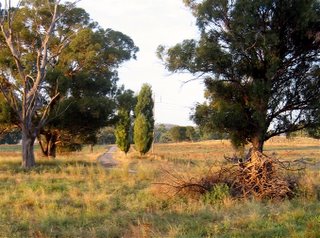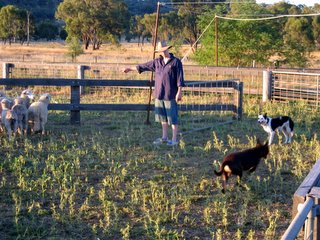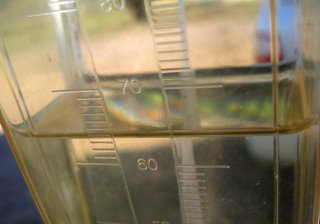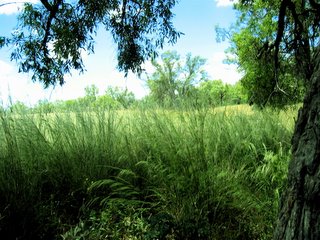

(This is an excerpt from a paper by Dr Christine Jones*, produced for the Living Soils seminars held in NSW recently. Information about Christine's Managing The Carbon Cycle Forums for the second half of this year appears at the end of this post.)
..............
Calculating volume and value of soil carbon
Soil carbon content is usually expressed as either a concentration (%) or a stock (t/ha). Unless the depth of measurement and soil bulk density parameters are known, it is not possible to accurately convert from one unit of measurement to the other.
For the sake of illustration however, some simple assumptions can be made. Changes in the stock of soil carbon (t/ha) for each 1% change in measured organic carbon (OC) status for a range of soil bulk densities and measurement depths are shown in Table 1. Numbers in brackets represent tCO2 equivalent. An explanation of these terms follows.
Soil bulk density (g/cm3) is the dry weight (g) of one cubic centimetre (cm3) of soil. The higher the bulk density the more compact the soil. Generally, soils of low bulk density are well structured and have ‘more space than stuff’. The lower the bulk density the more room for air and water and the better the conditions for soil life and nutrient cycling. Bulk density usually increases with soil depth. To simplify the table it was assumed that soil bulk density did not change with depth
CO2 equivalent. Every tonne of carbon lost from soil adds 3.67 tonnes of carbon dioxide (CO2) gas to the atmosphere. Conversely, every 1 t/ha increase in soil organic carbon represents 3.67 tonnes of CO2 sequestered from the atmosphere and removed from the greenhouse gas equation.
For example, from TABLE 1 we can see that a 1% increase in organic carbon in the top 20 cm of soil with a bulk density of 1.2 g/cm3 represents a 24 t/ha increase in soil OC which equates to 88 t/ha of CO2 sequestered.
..............................
TABLE 1. Changes in the stock of soil carbon (tC/ha) for each 1% change in measured organic carbon (OC) status for a range of soil bulk densities and measurement depths. Numbers in brackets represent tCO2 equivalent.

.....................Value of soil carbon.................
Sequestered carbon is a tradeable commodity. It has different values in different markets and the price is subject to market fluctuation. If the CO2 equivalent in the above example was worth $15/t, the value of sequestered soil carbon in ‘carbon credits’ would be $1,056/ha. If the soil carbon concentration was increased by 1% to a depth of 30cm rather than to 20 cm, this would represent 132 t/ha sequestered CO2 at a value of $1,980/ha.
If organic carbon concentrations were increased by 2% to a depth of 30 cm in the same example, this would represent $3,960/ha, that is, almost $400,000 in ‘carbon credits’ per 100 ha of regenerated land. These levels of increase in soil carbon are achievable, and have already been achieved, by landholders practicing regenerative cropping and grazing practices.
Even if organic carbon levels were only increased by 0.5% in the top 10 cm of soil this would represent 22 t/ha sequestered CO2 valued at $33,000 per 100 ha regenerated land (assuming a soil bulk density of 1.2 g/cm3 and a price of $15/t CO2 equivalent).
Carbon credits for sequestered carbon are not an annual payment. In order to receive further credits, the level of soil carbon would need to be further increased. It is also important that the OC level for which payment was received is maintained.
This is not difficult with regenerative regimes in which new topsoil is being formed. Biological activity is concentrated in the top 10cm of most agricultural soils, but regenerative practices rapidly expand this activity zone to 30 cm and deeper. Many benefits in addition to potential carbon credits accrue to increased root biomass and increased levels of biological activity in soil.
The majority of Australian soils have lost enormous quantities of organic carbon and this process needs to be reversed. What has gone up must come down. Soils, plants, animals and people will benefit when we take ‘recycle and re-use’ to the next logical step and recycle the excess carbon currently in the atmosphere.
Carbon and nitrogen
Nitrogen moves between the atmosphere and the topsoil in similar ways to carbon. The main difference is that the ‘way in’ for atmospheric carbon is via green plants whereas the ‘way in’ for atmospheric nitrogen is soil microbes. Soils acting as net sinks for carbon are usually also acting as net sinks for nitrogen. The flip side is that soils losing carbon are usually losing nitrogen too. In poorly aerated soils, some of this loss is in the form of nitrous oxide (N2O), a greenhouse gas up to 300 times more potent than carbon dioxide, while other losses include easily leached nitrate (NO3-) which often takes calcium, magnesium and potassium with it, leaving the soil more acidic (lower pH).
Rewarding landholders for farming in ways that build new topsoil and raise levels of soil carbon and nitrogen would have a significant impact on the vitality and productivity of Australia’s rural industries, reduce the incidence of dryland salinity and soil acidity – and reduce levels of greenhouse gases.
As a bonus, regenerative farming practices result in the production of food much higher in vitamin and mineral content and lower in herbicide and pesticide residues than conventionally produced foods.
A new era
If landholders were rewarded for regenerative practices that aggregate rather than aggravate soil structure, it would move us a long way towards solving the greenhouse gas ‘problem’, without the need to measure soil carbon levels at all. Any farming practice that improves soil structure is building soil carbon. When soils become light, soft and springy, easier to dig or till and less prone to erosion, waterlogging or dryland salinity - then organic carbon levels are increasing. If soils are becoming more compact, eroded or saline – organic carbon levels are falling.
Water, energy, life, nutrients and profit will increase on-farm as soil organic carbon levels rise. The alternative is evaporation of water, energy, life, nutrients and profit if carbon is mismanaged and goes into the air.
It’s about turning carbon loss into carbon gain.
............
*Christine Jones is a grassland ecologist with more than 30 years experience studying plant species. She has a PhD in agronomy and botany.
‘Managing the Carbon Cycle’ Forums will be held in Horsham, VIC, 26-27 July 2006; Katanning, WA, 2-3 August 2006 and Kingaroy, QLD, 25-26 October 2006. See www.amazingcarbon.com or contact Christine@amazingcarbon.com




































